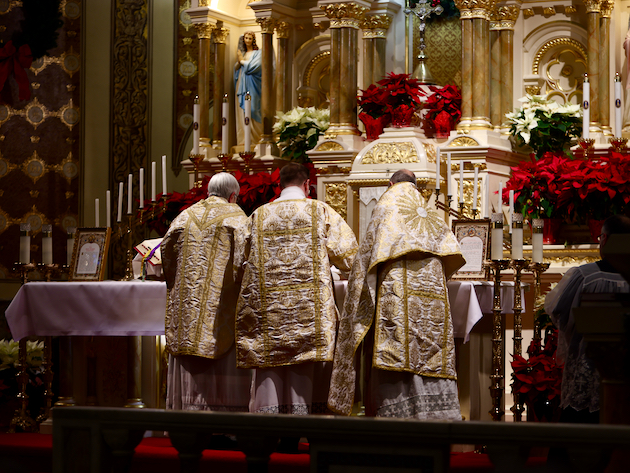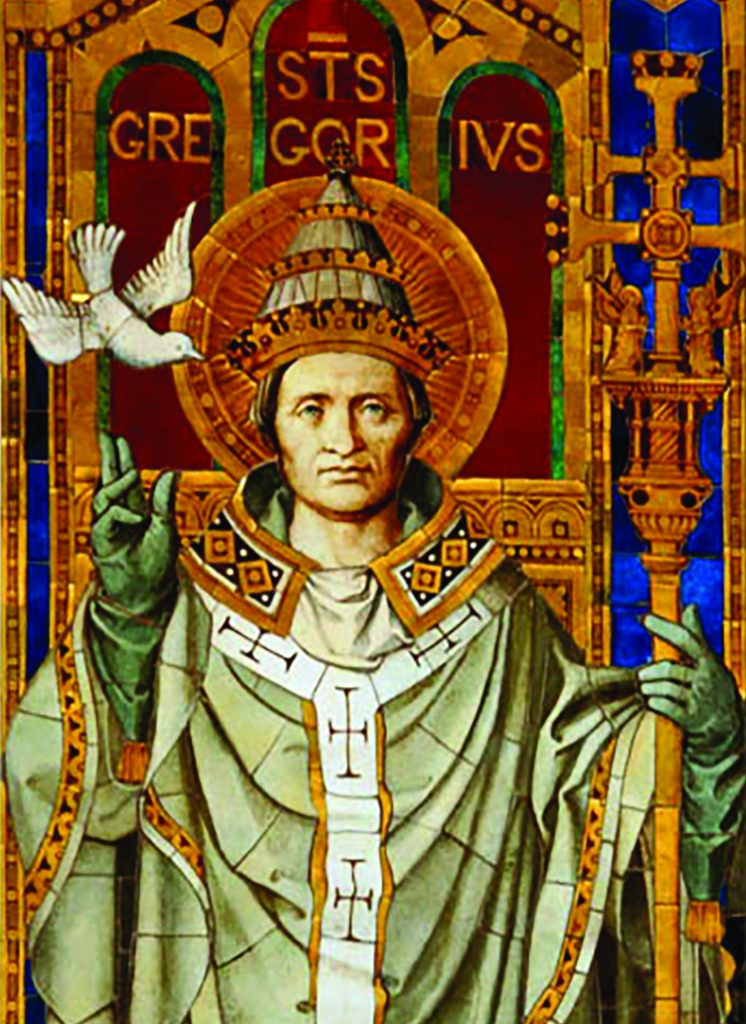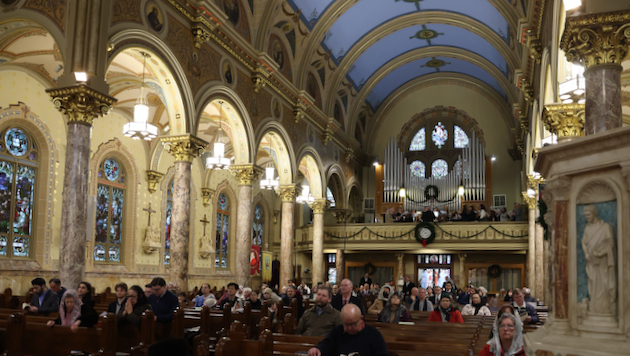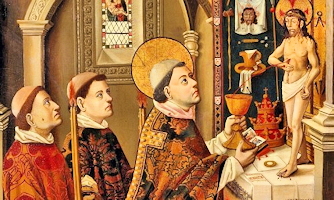After the suppression of the Latin Mass in New Haven at St. Stanislaus Church by the Archbishop of Hartford, the Executive Committee of the Saint Gregory Society met and resolved that the Society should continue in its mission in promoting the worldwide preservation and celebration of the traditional Latin liturgy of the Roman Catholic Church. To that end, the Society will continue to offer for sale its publications (liturgical calendars, audio recordings, and greeting cards) and to provide information and reflections on the traditional liturgy online through this website. Please visit this website regularly!
Requiescat in pace
The Officers of the Saint Gregory Society note with sadness the passing from this life of Mrs. Joanne Turecek, age 81, on Saturday, August 3, after a long illness. Joanne was a charter member of the Saint Gregory Society and of its Executive Committee. Her funeral will be observed in a Solemn High Requiem Mass on Friday, August 9, at 11:00 am, at Sts. Cyril and Methodius Church, 79 Church Street, in Bridgeport, CT.
Joanne is survived by her husband Donald, and four sons: Peter, Michael, Geoffrey, and Douglas. We encourage all members and friends of the Saint Gregory Society to offer prayers for the repose of her soul.
Final Latin Mass in New Haven — 14 January 2024

(photos courtesy of Stuart Chessman)
On Sunday afternoon of January 14, 2024, the final traditional Latin Mass offered in New Haven with the permission of the Archdiocese of Hartford for 38 years was celebrated at St. Stanislaus Church. The suppression of this regular celebration of the traditional Latin Mass in New Haven is a sad event in the history of our Society and a cruel deprivation to faithful Catholics in the New Haven community who are devoted to the age-old form of the liturgy of the Western Church.
Attended by a congregation of nearly 250 souls, the celebration of a Solemn Votive Mass in honor of our Patron, St. Gregory the Great, was a deeply devotional offering of the Holy Sacrifice. The Priestly Ministers–Celebrant, Deacon, and Subdeacon–were assisted by a full complement of Servers at the Altar. The Schola Cantorum of the Society aided by guest singers from other choirs, performed the Gregorian chants of the feast and William Byrd’s Mass for Three Voices. The Reverend Richard G. Cipolla’s remarkable sermon (posted below) served as a most apposite reflective meditation on the liturgy as it was experienced. All in all, it was a grand observance of a grim occasion.
We exhort all members and friends of the Saint Gregory Society, as well as any other Christians who recognize the infinite value of the traditional liturgy, to write respectfully to those responsible listed below expressing their dismay at the suppression of this Mass in New Haven.
Fr. Ryan Lerner, Pastor
Blessed Michael McGivney Parish
5 Hillhouse Avenue
New Haven, CT 06511
email: fr.ryan@st marysnewhaven.org
Fr. Sebastian Kos, Priest Administrator
St. Stanislaus Church
9 Eld Street
New Haven, CT 06511
email: ststanislaus@newhavencatholic.org
Rev. Msgr. James A. Shanley
Vicar for Clergy
134 Farmington Avenue
Hartford, CT 06105
The Most Reverend Leonard P. Blair, Archbishop of Hartford
134 Farmington Ave
Hartford, CT 06105
The Most Reverend Christopher J. Coyne, Coadjutor Archbishop of Hartford
134 Farmington Ave
Hartford, CT 06105
Sermon preached at Final Mass by The Rev’d. Richard G. Cipolla (text courtesy of Stuart Chessman)
“At a certain point the wine ran out, and Jesus’ mother told him, ‘They have no more wine.’ Jesus replied, ‘Woman, how does this concern of yours involve me? My hour has not yet come’. His mother instructed those waiting on table, ‘Do whatever he tells you.’” (John 2: 3-5)
The changing of water into wine, always the gospel for this Sunday, the third sign of the Epiphany: the adoration of Christ by the Wise Men, the Baptism of Christ, and the changing of water into wine. This is the first miracle of Jesus and the first of the seven signs in the gospel of John, the signs that point to who Jesus is, the signs that show forth his glory, in a hidden way, for his glory is only shown forth finally on the cross. This is a most homely miracle: no healing here, no miraculous feeding, no casting out of demons. It surely pales before the raising of Lazarus, the final sign before the glorification of the Passion and Resurrection. But it is such a wonderful miracle. It is purely gratuitous; it is overflowing with extra. The water changed into wine gives pleasure to the wedding guests; the choice wine was saved for last. And so much of it! Six jars of twenty-five gallons apiece.
But that is not the heart of this gospel. The heart of this gospel is the manifestation of Christ to his disciples. But close to this heart, beating simultaneously with it, is the meaning of Mary’s role in our redemption. The heart of this gospel is Jesus Christ; but the wedding feast at Cana is where the biblical foundations of devotion to Mary are found, those foundations that end as they must, as all devotions must, at the foot of the Cross. One of the fundamental differences between Catholicism and Protestantism is the role of Mary in faith and piety. Devotion to Mary is one of the constants of the Catholic faith, and it is this devotion that is the evidence of a living faith in Christ. The rejection in Protestantism of Mary’s role in Christian faith has had the result of a widespread loss of understanding of who Jesus is. For without Mary, the reality of Jesus Christ is compromised.
They have no more wine. Woman, how does this concern of yours involve me? My hour has not yet come. Does not this exchange between Jesus and his mother give us pause? His address to her: Woman. Not Mother: Woman. We can rush to point out that this was a polite form of address in Semitic culture. The problem here is the translation. There is no way to say this in English as it would have been said in Aramaic. But the meaning of the gospel does not ultimately depend on language and culture. The conversation between Jesus and his mother—and please note that John the Evangelist never calls Mary by her name: he always refers to her as the mother of Jesus—this conversation is important to Christian faith because of what it says about Mary and the therefore about Jesus, for Mary always points to Jesus.
Where do we begin in understanding this conversation? We begin with the Revelation of St. John, where the Woman—that is the term used—is that mysterious, symbolic figure who is a key figure in the drama of salvation. She is the Woman who gives birth to the male child and enters into conflict with the dragon serpent. The imagery here forces us back to the third chapter of Genesis, to the Fall, where enmity is place between the serpent and the woman, between the serpent’s seed and her seed. In Revelation the Woman in birth pangs brings forth a male child who is the Messiah and is taken up into heaven. The great dragon, identified as the ancient serpent of Genesis by Revelation, frustrated by the child’s ascension, turn against the Woman and her offspring. Tradition understands this Woman as the people of God, the new Israel. Tradition understands this Woman as the Church who continues on earth after the Ascension, persecuted but protecting her children. But the Tradition of the Church identifies this woman, the Woman, also as Mary, the mother of Jesus, the mother of the Messiah. For it is Mary who is the symbol of the Church in the deepest sense, Mary who is the mother of the Church, but above all, Mary who is the new Eve, who by her Yes overturns the bondage and death of Eve’s No.
This is the context is which we must understand the conversation between Mary and Jesus at the wedding feast at Cana. It is Mary, the mother of the Messiah, the new Eve, who utters the words: they have no wine. This is not only a fact; it is a request to perform a sign that will show the glory of God in the Savior of the world. But before Jesus performs this sign, he must make clear his refusal of Mary’s intervention—how does this concern of yours involve me? She cannot have any role in his ministry. His signs must reflect the absolute sovereignty of his Father, not any human or family agency. What he must do, he must do alone, he who was born not by blood, not be carnal desire, nor by man’s willing it, but by God. But it is the new Eve who makes this request. It is the handmaid of the Lord who makes this request. And so just as Eve’s request of Adam brought sin into the world, so Mary’s request is the occasion of Jesus’ epiphany to his disciples, the first manifestation of his glory. And this request is granted: the water is changed into wine. But Mary’s ministry, her role in the redemption, must wait, must wait until the glorification of her Son, the final manifestation, the final epiphany. It is only at the final battle between the Son and the serpent that is waged on the Cross: it is only the hour of passion, death, and resurrection and ascension. Here is Mary’s fundamental role, her ministry. It is as the Woman: Woman, behold your Son! Here is the final struggle of the Woman with the serpent. It is here that she is entrusted with offspring whom she must protect in the continuing struggle between Satan and the followers of the Messiah. Here at the foot of the cross is Mary, mother of the Church. Here Mary is our mother, our protector, we who are the offspring of the Church, we who have been born again at the font by water and the Holy Spirit. Here is our Lady of Perpetual Help, here is our succour, our light, our sweetness and our hope, here is the Mother of all Christians, enveloping us in her mantle, the mantle that warmed the hillside of Tepeyac so that roses bloomed in the winter.
So many words, too many words, all of this, so much breathing out into the void! But how else to say this which must be said? Much better to go to Chartres to see who Mary is in the stone of the vaulting that soars to heaven and in the windows filled with the deep blue and blood red glass that speak so eloquently of beauty, of the Woman, and the glory of her Son. Much better to go to Torcello to see the Byzantine mosaic in the apse of the cathedral and see in that severe gold and blue the steely courage of the Theotokos, the bearer of God. Much better to go to my grandmother’s parish church in Campagna to see the heartbreaking statue of the Madonna Addolorata, our Lady of Sorrows, her heart pierced by swords, lovingly dressed in her liturgical outfits, her fragile porcelain face marked by tears, and here understand the deep suffering love that is Mary’s love for her Son and for the Church. Much better to join in singing the solemn tone of the Salve Regina, for it is the act of singing this hymn that the deepest understanding takes place, that water into wine makes sense, that my life in Christ makes sense—that Love makes sense.
And yet—and yet—we cannot pretend that this is just another Second Sunday after Epiphany and just look forward to the next year when this Gospel is sung, the singing itself an echo of the very molecules of water that were in those large vats at the wedding feast, those molecules that were surprised in their ordinariness of a v-shaped molecule with a `108° angle with the oxygen at the top of the molecule by the sudden presence of ethanol molecules with their little chains and the phenolic compounds that come from the grapes whose complexity lies at the heart of the mystery of wine. You cannot reduce wine to its chemical components. For wine is after all a mystery, which both Jesus and his mother understood, as work of human hands that can never be reduced to its components but rather can only be understood in terms of the happiness of the bride and groom and the wedding guests at that wedding. The Mass of Catholic Tradition, whose growth lies hidden in history, cannot be analyzed by listing its parts or by examining it as if it were an historical document. Like wine, this Mass is an experience, not a text.
How wonderful that the setting of the Ordinary of this Mass today is William Byrd’s Mass for Three Voices, written by the Catholic Byrd during the Elizabethan persecutions. The liturgy in the Book of Common Prayer is marked by wonderful English. Just the Advent Collects, translated by Thomas Cranmer, are masterpieces of English and masterpieces of the attempt to translate Latin into any language. But yet, yet, this is manufactured beauty. It is not organic. It did not come from the womb of Catholic Tradition that gave birth not merely to Councils with their edicts, but also, and just as importantly, to Collects and the Canon of the Mass and just as important to that Gregorian chant that makes words come alive in a way that points in a visceral way to the heaven that lies at the heart of the Mass.
If I were to be elected Pope, which is possible but highly unlikely, I would canonize William Byrd for his courage in a time of persecution. But even more for his understanding of the intrinsic relation between music and the Mass, a relation that has had a rocky road for centuries after Byrd and Tallis and Palestrina and Victoria and yes, even the great Bach, culminating in the tragedy of the 1960’s and 70’s.
I cannot help but feel sorrow on this day. I feel sorrow for this church, this building itself, a place built by immigrants to this country who because they understood the role of beauty, not only in the building itselft, but also in what the building is built for, the Holy Sacrifice of the Mass. The Mass for which this church was built will no longer be celebrated here, and if walls could weep, they would be weeping at this very moment. This is an age in which the Church has forgotten the three names of God: Truth, Goodness, and Beauty. Lip service is given to Truth and to Goodness. But the denial of the beauty that lies at the very heart of the Mass, that is ever ancient, ever new, all for which St. Gregory worked so brilliantly is a sign of blindness to the fact that beauty has saved the world, beauty is saving the world, beauty will save the world.
But there will come a time when the beauty of our Catholic Tradition will be rediscovered. And that time has already begun. Those young people, those Yale students, who come to this Mass more and more frequently, have discovered the relationship between the Mass and the Beauty of God–something that they had never thought of before or experienced. And there are others who are experiencing this relationship elsewhere, and they are the future of the Church. All the young people here, you are the future of the Church, not those mired in the 1960s and 1970s. When I am tempted to get mad or sad about the state of the world and the state of the Church, I remember Jesus’ words: “Fear not, little flock, for I have overcome the world”.
So now after this barrage of words that always fade into nothing, we proceed to the heart of the matter, where words do not merely change water into wine, but words effect an infinitely greater miracle, but not merely words or mere words or random words but the words of Him through whom the universe was created: Hoc est corpus meum. And there is nothing else to say. But much more to sing. And we will sing again.
Final Latin Mass at St. Stanislaus Church in New Haven on Sunday, January 14: Solemn Votive Mass of St. Gregory the Great
The final service in the traditional Latin (“Extraordinary”) form of the liturgy permitted in our community by the Archdiocese of Hartford will be celebrated in a Solemn Votive Mass of St. Gregory the Great, patron of our Society, on Sunday January 14 at 2:00 pm at St. St. Stanislaus Church, State Street at Eld Street, New Haven. The Mass, followed by Benediction of the Blessed Sacrament, will be celebrated by the Rev. Richard G. Cipolla, Pastor Emeritus of St. Mary’s Church, Norwalk, and longtime supporter and chaplain of the Society. [Please note Fr. Cipolla’s communiction below.} The Rev. Robert L. Turner, Pastor of St. Ambrose Parish, North Branford will be the deacon and The Rev. Peter Langevin, Chancellor of the Diocese of Norwich, will be the subdeacon. The Gregorian chant and polyphonic music for the service will be provided by the Schola Cantorum of the St. Gregory Society.
The Officers of the Saint Gregory Society encourage all who are devoted to the traditional Liturgy to plan to attend this service, to bring family and friends, and to invite others to attend and witness this historical, if ominous, event in the life of the Church in our area.
COMMUNICATION FROM THE REV. RICHARD G. CIPOLLA
The recent announcement from the Archdiocese of Hartford that the Traditional Mass is suppressed at St. Stanislaus in New Haven is a source for me of deep sadness. The St. Gregory Society was founded 38 years ago to offer the Traditional Mass, especially in the beauty and depth of the Solemn form, as a positive response to St. John Paul II’s Indult allowing the use of the 1962 Missal. Not only did the Society play an important role in the regular restoration of the Traditional Mass but also brought back Beauty as an intrinsic and central element of the celebration of Holy Mass. The Society of St. Gregory’s importance to me is indeed great, for it was at my first celebration of the Traditional Roman Mass over twenty years ago in Sacred Heart church in New Haven that I first understood the transcendental power of the Mass and its deep relationship to the Beauty of the person of Jesus Christ who is both Priest and Victim.
I am convinced that despite the foolish and painful attempts in this pontificate to radically suppress the Mass of Catholic Tradition, Beauty is stronger than ignorance and oppression. In a real way the parishes that have offered and still offer that Traditional Mass are in debt to the St. Gregory Society for its leadership beginning 38 years ago to the present time. I would ask that as many Catholics who love the Traditional Roman Mass attend the “last” Traditional Mass in New Haven at St. Stanislaus Church on Sunday 14 January at 2 p.m. For the laity to show great support for the Traditional Mass is necessary at this time to counter the forces of reaction within the Church that have deliberately forgotten that the Mass is not self-worship but the worship of the transcendent God in the person of Jesus Christ.
Oremus pro invicem.
Father Richard Gennaro Cipolla, Ph.D., D. Phil.(Oxon)
Traditional Mass in New Haven Canceled by Archdiocese at the request of local pastor. Last Latin Mass in St. Stanislaus Church in New Haven will be January 14
In a sudden announcement read before Mass was to begin at St. Stanislaus Church in New Haven on Sunday, December 31, Fr. Sebastian Kos, Priest Administrator of St. Stanislaus Church, announced that the regular celebration of the traditional Latin Mass in New Haven was to be canceled. Permission for the cancellation was requested by Fr. Kos and Fr. Ryan Lerner, Pastor of Blessed Michael McGivney Parish, and granted by The Most Reverend Leonard P. Blair, Archbishop of Hartford. The last official Mass in the traditional form is to be celebrated on Sunday, January 14, at 2 p.m.
The announcement came as a shock to the congregation and leadership of the St. Gregory Society of New Haven, the organization that has sponsored the Masses for the 38 years of its existence. In making his decree, Archbishop Blair noted two reasons: alleged declining attendance (in fact, attendance is up) and staffing the Mass with priests competent to celebrate the ancient rite. Chairman of the St. Gregory Society, Nicholas Renouf, who was in attendance, was as surprised by the announcement as the congregation, and had to field questions from concerned congregants following the service.
Permission for the celebration of the Latin Mass in New Haven was granted by the late Archbishop John F. Whealon, following the indult Quattuor abhinc annos, promulgated in 1984 by Pope St. John Paul II. The indult gave limited permission for use of the pre-Vatican II Roman Missal. The St. Gregory Society of New Haven was estasblished in 1985 to fulfill the requirement of the petitioning process to demonstrate a stable group of faithful who desired the older rites.Archbishop Whealon responded by allowing three locations in the Archdiocese to regularly celebrate Mass according to the “Tridentine” Missal.
The first Latin Mass under the terms of the indult was celebrated on January 12, 1986, in Sacred Heart Church, New Haven, where its regular celebration remained until that church was closed in 2009. At that time, the Society was invited to use St. Stanislaus Church and has remained there ever since.
“It is ironic the last traditional Latin Mass allowed by the Archdiocese, this Janury 14, is the 38th anniversary of a Latin Mass presided over by Archbishop Whealon at Sacred Heart Church, was attended by nearly 1,000 people,” said William Riccio, the master of ceremonies of the SGS.
In its 38-year history, the services sponsored the Society have become known for the beauty of the liturgy and the music to accompany it. The Schola Cantorum of St. Gregory Society was invited to many locations to sing for other Latin Masses. Moreover, its Master of Ceremonies helped train many dozens of priests and servers to learn the rites. It would be no exaggeration to say many of the Latin Masses celebrated in Connecticut, New York, Massachusetts, and even Pennsylvania have been aided by the efforts of the Society. Among the musicians in the Schola there have been several conversions, and a number of its alumni have gone on to establish Scholas in other churches throughout the country.
The Mass on January 14, the Second Sunday after Epiphany, will be celebrated by the Rev. Richard G. Cipolla, former pastor of St. Mary’s, Norwalk, and longtime supporter and chaplain of the group. The Gregorian chant and polyphonic music for the service will be provided by the Schola Cantorum of the St. Gregory Society.



